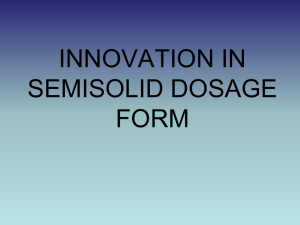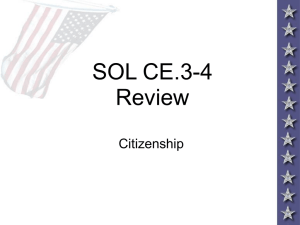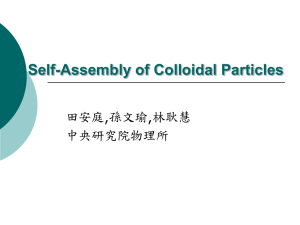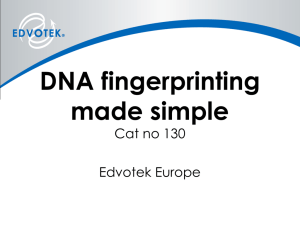Chapter 9 Synthesis Methods Hong
advertisement
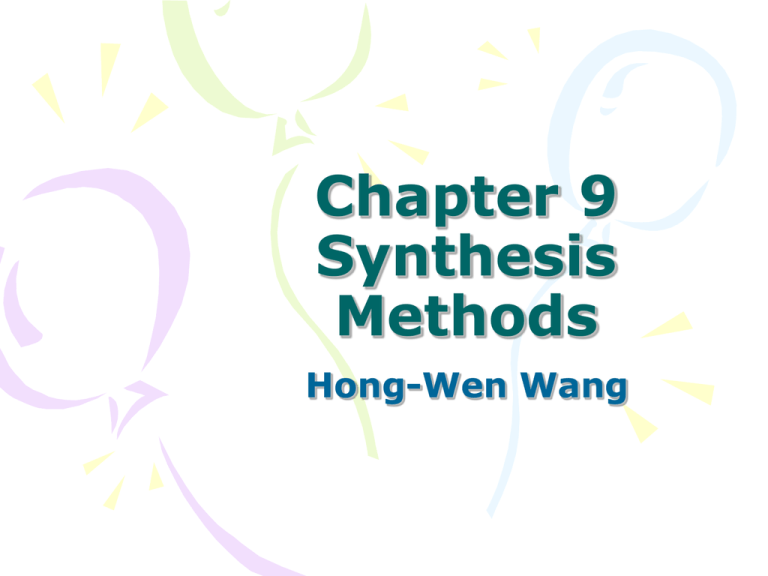
Chapter 9 Synthesis Methods Hong-Wen Wang How to prepare ceramic powders ? Sol-Gel Process • Aqueous solution (from metal salts or colloidal particles) particulate sol and gel. • Non-aqueous solution (from metal alkoxides) polymeric sol and gel. • Advantages – High chemical homogeneity, particularly for multicomponent – Ultrahigh purity – High surface area, powder, or gels. – Spherical powder, fiber, thin film, coating can be made. What is Sol ? Gel ? Colloidal sols ? Polymeric sols ? • Colloid means : – A suspension containing dispersed particles of 1~1000 nm – Gravitational force are negligible – Interactions are dominated by shortrange forces. – Require adjust pH to make good dispersive particles – Colloidal sol sometime is called particulate sols. What is Sol ? Gel ? Colloidal sols ? Polymeric sols ? • Sol: – A homogenous dispersion of soluble solids and miscible liquids, is consisted of finely divided, discrete particles of 1~10 nm in diameter – A “colloidal sol” consists of dense (oxide or hydroxide) particles 1~1000 nm which therefore include colloidal dispersion and colloidal suspension. – Line which distinguishes a dispersion (1~10nm) from a suspension (>10nm) is generally accepted at an equivalent spherical diameter (e.s.d), 10 nm What is Sol ? Gel ? Colloidal sols ? Polymeric sols ? What are the precursors for Sol-Gel ? • For Al2O3, the precursors may be Al(OC4H9)3 , alkoxide • Alkane: CnH 2n+2, a molecule containing only carbon and hydrogen linked by single bond. Such as methane: CH4, ethane: C2H6. • Alkyl: CnH 2n+1, a ligand formed by removing one hydrogen from Alkane. Such as methyl: ·CH3, ethyl: · C2H5 • Alcohol: a molecule formed by adding a hydroxyl (OH) group to an alkyl. Such as methanol: CH3OH, ethanol: C2H5OH. • Alkoxy: a ligand formed by removing a proton from the hydroxyl on a alcohol. Such as methoxy: ·OCH3,, ethoxy: ·OC2H5 Silicon Tetraethoxide (tetraethyl orthosilicate, TEOS) and Ti- tetraisopropoxide R O R O Si O R O R=C H 2 5 R R O R O Ti O R • Ti(OC3H7)4 O R=C3H7 R • Si(OC2H5)4 What are the reactions of Sol-gel ? • Metal alkoxides react readily with water. • Hydrolysis – Partially hydrolysis • Si(OR)4 + H2O HO-Si(OR)3 + ROH • Si(OR)4 + nH2O (HO)n-Si(OR) 4-n + nROH – Complete hydrolysis • Si(OR)4 + 4H2O Si(OH)4 + 4ROH R = CH3, or C2H5 or CnH2n+1 What are the reactions of Sol-gel ? • Two partially hydrolyzed molecules can link together condensation reaction – (OR)3 Si-HO + HO-Si(OR)3 (OR)3 Si-OSi(OR)3 + H2O or – (OR)3 Si-RO + HO-Si(OR)3 (OR)3 Si-OSi(OR)3 + ROH • Continuous 3-D condensation polymerization polymeric gel What are the reactions of Sol-gel ? Process 1 : From metal salts particulate gels • M+n + n H2O M(OH)n + n H+ – Ti+4 + 4 H2O Ti(OH)4 + 4 H+ • The reaction is enhanced by adding a based solution • Dense precipitates • Gelation by dehydration of the solution or by alkaline gelation when the pH of the solution is increased and repulsive force between particles is reduced. • Spontaneous coagulated Particulate gels. What are the reactions of Sol-gel ? From metal alkoxides both polymeric gels and particulates gels • Three steps: – Hydrolysis of metal alkoxides to give precipitates or polymeric sols – Defloculation of the residual metal hydroxides to a clear sol. – Gelation to gels for both polymeric and particulate gels. Hydrolysis and Condensation • Hydrolysis and condensation can be catalysed by : – Addition of acid or base: HCl, acetic acid, HF or NH3, KOH, KF… – Important parameters : • water-to-alkoxide ratio • pH value • Type of solvent • Temperatures • Silica gels are prepared by hydrolysis of TEOS with a mineral acid (HCl) or base (NH3) as a catalyst. – Acid catalysed, pH<2.5 linear polymeric gel – Base catalysed, high pH particulate gel Examples of Sol-Gel powders • Sol-gel alumina, Al2O3 Aluminium alkoxides Al(OC3H7)3 aluminium isopropoxide Al(OC4H9)3 aluminium secbutoxide i.e. Al (OR)3…… Starting precursors Excess water Vigorous stirring (80oC, hydrolysis reaction) Deflocculation monohydroxide Polymerized gel Al2O3 Add acid (HCl, HNO3, CH3COOH) Non-complexing anion with Al, and Produce a charge effect at low conc. Examples of Sol-Gel powders • Sol-gel Barium Titanate Titanium tetra-isopropoxide Ti(OC3H7)4 Acetic Acid Titanium precursor Barium acetate (aqueous solution) Gelation Chemical Polymerization Drying and Calcination BaTiO3 powders What is Hydrothermal process ? Feedstock preparation Reagents Growth control agents Oxides/Hydroxides/salts Gels /Organics/Acids/Bases Reactor Batch oxidizing Temperature (100 to 350oC) Pressure (<15MPa) Residence Time (5-60mins) Pressure Let-down Filtrating/washing/drying crystalline powder What is Hydrothermal process ? • Hydrothermal dissolution/precipitation reaction – the basic mechanism for the hydrothermal formation of ceramic oxide particles A(OH)s + B(OH)s A(OH)aq + B(OH)aq ABO3 Dissolution Precipitation Poorly Ordered Precursor Crystalline Hydrothermal Product What is Hydrothermal process ? • Hydrothermal synthesis – – – – An aqueous chemical process Typical reacting temperature 100~374oC Pressure range 0~15MPa The product is crystalline anhydrous ceramic powders with controlled particles size, controlled stoichiometry, and controlled particle shape. (calcination is not necessary.) – Starting precursor can be inexpensive oxides, hydroxides, chlorides and nitrates. Hydrothermal process for MnZn Ferrite


